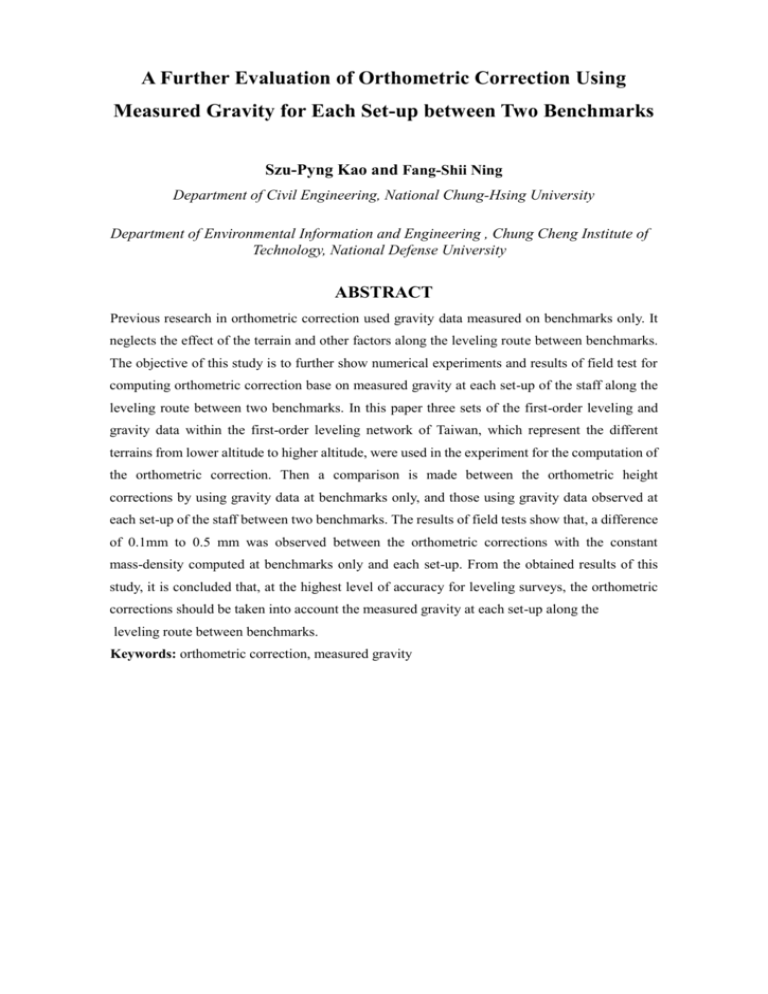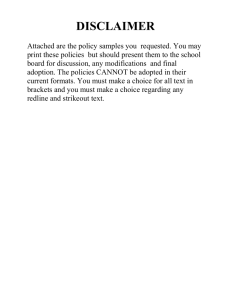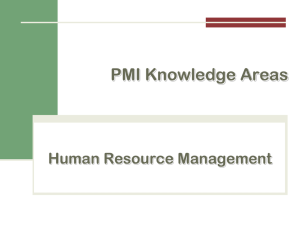The Effect of Orthometric Height Correction Uses
advertisement

A Further Evaluation of Orthometric Correction Using Measured Gravity for Each Set-up between Two Benchmarks Szu-Pyng Kao and Fang-Shii Ning Department of Civil Engineering, National Chung-Hsing University Department of Environmental Information and Engineering , Chung Cheng Institute of Technology, National Defense University ABSTRACT Previous research in orthometric correction used gravity data measured on benchmarks only. It neglects the effect of the terrain and other factors along the leveling route between benchmarks. The objective of this study is to further show numerical experiments and results of field test for computing orthometric correction base on measured gravity at each set-up of the staff along the leveling route between two benchmarks. In this paper three sets of the first-order leveling and gravity data within the first-order leveling network of Taiwan, which represent the different terrains from lower altitude to higher altitude, were used in the experiment for the computation of the orthometric correction. Then a comparison is made between the orthometric height corrections by using gravity data at benchmarks only, and those using gravity data observed at each set-up of the staff between two benchmarks. The results of field tests show that, a difference of 0.1mm to 0.5 mm was observed between the orthometric corrections with the constant mass-density computed at benchmarks only and each set-up. From the obtained results of this study, it is concluded that, at the highest level of accuracy for leveling surveys, the orthometric corrections should be taken into account the measured gravity at each set-up along the leveling route between benchmarks. Keywords: orthometric correction, measured gravity 利用水準點間每個觀測位置實測重力值進一步評估 正高改正之研究 高書屏 甯方璽 國立中興大學土木工程學系 國防大學理工學院環境資訊暨工程學系 摘 要 以往的正高改正研究所使用的重力數據皆僅使用在水準點上觀測之重力值,如此將忽略 在水準點間之地形及沿著施測路線上其他的影響因素。因此,本研究於兩水準點間進行一等 水準測量並同時於標尺擺設處實施重力測量,利用實測重力值進行正高改正之研究,針對計 算出測線之正高改正結果進行分析。本文選擇台灣地區水準網中代表不同地形的 3 段水準測 線進行一等水準測量及重力測量,以計算不同地形之正高改正進行研究。 本研究採用質量密度一致進行計算以比較利用兩水準點上之重力數據計算之正高改正與 兩水準點間一等水準測量時各標尺擺設處實施重力測量 累積所計算之正高改正,其結果顯示 正高改正有 0.1mm~0.5mm 之間的差異。最後根據本研究所獲得的結果顯示,於高精度水準 測量進行正高改正時需以沿水準路線各標尺擺設位置之實測重力以進行計算。 關鍵字:正高改正,實測重力值 I. INTRODUCTION on leveling results is a systematic one that On the basis of former research results will accumulate over long leveling runs. in orthometric corrections conducted by The process of computing the orthometric the authors [5], the further verification of height correction uses gravity at the two measured gravimetric observation for adjacent benchmarks only in the past [5]. each set-up between two benchmarks is It was also recommended that orthometric carried on three leveling traverse of corrections, which take into account several first order benchmarks at various observed terrains in Taiwan island. mass-density, be considered in any future gravity and topographic The orthometric height can be redefinition of the Australian Height approximately obtained by spirit leveling Datum [1]. In this research a comparison and gravity corrections. The height will be made between orthometric height difference from leveling must be corrected correction results using measured gravity for non-parallel equipotential surfaces data at benchmarks only, and using using the orthometric correction in order measured gravity data at set-up of the staff to obtain orthometric height. As we know between benchmarks. These lines and one that the effect of orthometric corrections loop within the first-order leveling and gravity network of Taiwan were used that distance of 2Km between existing represent the different terrains to compute benchmarks of Taiwan [4]. The results orthometric corrections via three formulae from such experiments are discussed in at only two benchmarks, and also at every this paper. set-up of staff. The objective of this research is to determine whether these are significant differences via three formulae II.METHODOLOGY at only benchmarks, and at every set-up of The separation of benchmarks in Taiwan is approximately two kilometers. Precise leveling takes place from staff. Three different terrains, from flat area (with an average elevation 81.544m), mountain area (with an average elevation 1797.950m) to higher mountain area (with an average elevation 3165.233m), were chosen and used as the example test surveys to fully test the effect. Since the first-order leveling and gravimetric surveying used for this field experiment at every set-up of staff will cost a lot of money, time and man powers, therefore only three different terrains will be conducted to see the inherent difference between three different formulae. The leveling traverses and loop observed for this study followed part of a first-order benchmark A to benchmark B. The geodetic height is the distance of a point above an ellipsoidal surface. The difference between a point's geodetic height and its orthometric height equals the geoidal height. The level run is divided into set-up as shown in Figure 1. This study uses all gravity measurements and precise leveling to compute the orthometric height corrections of each section. It shows that the summation of orthometric corrections of the sections at every set -up of the staff between the two benchmarks compares well with doing the orthometric correction at two benchmarks only. leveling network of Taiwan and covers a i+1 i B Surface A H Plumb line g required i HB HA (orthometric height) Geoid (surface potential W o) A0 B0 N (geoidal height) h (ellipsoidal height) Ellipsoid Fig.1. The scheme of precise leveling set-up between benchmark A and B. Orthometric correction equations and g A , g B is observed gravity of benchmark the more precise equations reported in this A and B. paper are used to compute three leveling traverses, and one leveling loop. The (III) The very approximate formula for the results are compared and analyzed. The orthometric height correction is adopted formulae in this section were OC3 0.114 10 3 H m H AB 1.02 10 3 (g BB g AB ) H m quoted from the authors [5] as follows: 0.83 10 3 sin 2 m S H m (mm) [8] (I) The orthometric height correction where: m , and H m are the mean latitude and, formula used normal gravity. OC1 1 0 hA ( A B ) hAB ( AB B ) mean height between two bench marks. g AB , g BB represents the Bouguer gravity (mm) [7] where (3) (1) AB is conventional 1 ( A B ) . 2 abbreviated anomalies of points A and B, respectively. S represents the north-south distance of The two set-ups or benchmarks. series describing the variations in normal gravity III. DESCRIPTION OF THE TEST on the ellipsoid with geodetic latitude (), SUBJECTS and after substituting the constants for In this study, three leveling lines within the GRS80 is: first-order leveling network of Taiwan, each 978032.7(1 0.0053024 sin 2 approximately 2 kilometers long, are selected as 0.0000058 sin 2 2 ) the subjects for the numerical tests to examine (gal) [3] how the density of the gravity measurements h A is height of benchmark A and hAB is influence orthometric corrections between two height difference between benchmarks A adjacent an B. benchmarks(B.M.). representative (II) The orthometric correction calculated OC 2 0 (mm) [7] H A ( g A g B ) H AB ( g AB g B ) (2) where: g A g A 0.0424 H A g B g B 0.0424 H B g AB 1 (g A g B ) 2 are: flat three section (Q053~Q054), mountain section (C045~C046) by observed gravity. 1 sections The and high mountain section (Q060~Q062). The elevations vary irregularly from 81m to 3165m stretching over plain, hill and mountain. In high mountain area, three benchmarks connected as a loop were also used for the numerical checks of loop closure. The first-order leveling was measured by using Leica NA3003 digital level and gravimetric measurements was measured by using Lacoste & Romberg G model sections of leveling lines and loop are shown in gravimeter. The data of the respective Table 1. Table 1.Data Sheet of points in section of leveling line and loop Terrain B.M. ID Orthometric Height (m) Observed gravity (mgal) Q053 69.279 978786.6710 Q054 93.808 978785.5678 C045 1734.378 978487.8239 Flat area Mountain Area High Mountain Area C046 1861.521 978461.8321 C060 3090.096 978221.8410 C061 3275.704 978184.6272 C062 3129.900 978223.3992 Average elevation No. of set-ups (m) Between B.M. Distance (Km) 81.544 20 1.8 1797.950 42 2.0 3182.900 74 1.9 3202.802 58 2.0 IV. ANALYSES OF THE RESULTS A. Case of The Leveling Line in Flat mentioned above to find the difference. Area Table 2 lists the computed orthometric The survey results for the flat area corrections out of the three formulae. No Q053~Q054 is shown below. The profile significant differences are found within and the results of the Q053~Q054 section the results out of Eq(1), Eq(2) and Eq(3) of leveling line are illustrated in Figure 2 itself with on benchmarks and every and Table 2, respectively. The leveling set-up of staff. However, the orthometric section benchmarks corrections by Eq(2) and Eq(3) are many computed the accumulated orthometric times larger than Eq(1). A difference of correction just on benchmarks and every 0.1mm and opposite sign was also set-up of staff out of the three formulae observed between Eq(2) and Eq(3). of Q053~Q054 110 100 Benchmark Q054 Elevation (m) 90 Set-up 80 70 BenchmarkQ053 60 978783 978784 978784 978785 978785 978786 978786 978787 978787 Observed gravity (mgal) Fig. 2. Elevation and observed gravity of every set-up of leveling line in flat area. (Q53~Q54) Table 2. The total orthometric correction for each equation (between benchmarks Q53~Q54). Spacing of used for orthometric Total orthometric correction of two benchmarks (mm) correction Eq(1) Eq(2) Eq(3) Every staff setting up -0.022 -0.082 0.183 On benchmark only -0.021 -0.081 0.187 B. Case of The Leveling Line in Mountain Area In the mountain area, leveling observations from benchmark C045 to C046, gravity is surveyed at every staff set-up. There are 42 set-ups totally between C045 and C046 benchmarks. The profile and the results of this leveling line are illustrated in Figure 3 and Table 3. 1870 Benchmark C046 1850 1830 Elevation (m) Set-up 1810 1790 1770 Benchmark C045 1750 1730 978460 978465 978470 978475 978480 978485 978490 Observed gravity (mgal) Fig. 3. Elevation and observed gravity of every set-up of leveling line in mountain area. (between benchmarks C045~C046) Table 3. The total orthometric correction for each equation. (between benchmarks C045~C046) Spacing of used for Total orthometric correction of two benchmarks (mm) orthometric correction Eq(1) Eq(2) Eq(3) Every staff setting up -0.919 27.848 25.720 On benchmark only 27.886 25.825 -0.917 The average height in mountain area is Eq(3), concluded that in high elevation 1797.950m high and height difference area observed gravity should be used to around 120m so orthometric correction is compute orthometric correction rather large than flat area. The orthometric than normal gravity. Again the greater corrections show the more sensitive to the height difference and the higher mean height and change in height. [1][5]. The elevation between two benchmarks incur summation of orthometric corrections of the larger correction pointed out by Kao et. every staff setting up are almost the same al was also found in Table3 . as only computing benchmarks on the two ends of leveling line, in Eq(1) and Eq(2). C. Test Loop in High Mountain Area From the Table 3 obtained results, that For this research purpose in a high Eq(1) with large difference than Eq(2) and mountain area a leveling loop from benchmarks C060 to C062 via C061, then benchmark C060. When conducting a back to C060 was used. Tables 4, 5, 6 and level survey from C060 to C062, a gravity Figure 4,5 show the results for the testing survey is also used on each staff set-up. loop. When the leveling is complete, the Again, the sums of the orthometric survey resumes at benchmark C062, then correction from Eq(1) to Eq(3) are passing calculated and displayed in Tables 4 and 5. different benchmark routes, C061, and except closes to 3300 Benchmark C061 3250 Set-up Elevation (m) 3200 Benchmark C062 3150 3100 BenchmarkC060 3050 978180 978185 978190 978195 978200 978205 978210 978215 978220 978225 978230 Observed gravity (mgal) Fig. 4. Elevation and observed gravity of every set-up of leveling line in mountain area. (C060~C061~C062) The profile of leveling line (m) 3300 C061 3250 3200 C062 3150 C060 3100 3050 3000 2950 1 6 11 16 21 26 31 36 41 46 51 56 61 66 71 76 81 86 91 96 101 106 111 116 121 126 131 136 141 146 151 Gravity measurement's spots between benchmarks Fig. 5. Profile of leveling line in high mountain area (between benchmarks C060~ C062) Table 4. The total orthometric correction for each equation (between benchmarks C0060~C061) Spacing of using orthometric Total orthometric correction of two benchmarks (mm) correction Eq(1) Eq(2) Eq(3) Every staff setting up 3.242 69.107 65.733 On benchmark only 3.246 69.208 66.287 The table 4 shows the summation of is going up (around 3090m to 3275m), so orthometric corrections of every staff the orthometric height corrections are setting up are almost the same as only positive. From Table 4, it was showed that computing benchmarks on the two ends of orthometric corrections are significant for leveling line in orthometeric correction Eq(2) and Eq(3). This problem is ture of equation of applying Eq(1) formula. A spirit leveling lines that traverse(east-west) difference of 0.1mm across north-south oriented mountain was observed between Eq(2) and a difference of 0.5mm ranges[2][5]. was observed between Eq(3). And one can find out that the route of leveling line Table 5. The total orthometric correction for each equation (between benchmarks C0061~C062) Spacing of using orthometric Total orthometric height of two benchmarks (mm) height correction Eq(1) Eq(2) Eq(3) Every staff setting up -1.013 -50.217 -57.773 On benchmark only -1.016 -50.557 -57.347 The Table 5 shows the same trend of Eq(2) and 0.4mm for Eq(3) was found. Table 4 that every staff setting up are And one can also find out that the route of almost the same as only computing leveling line is going down (around benchmarks on the two ends of leveling 3090m to 3275m), so the orthometric line in Eq(1). A difference of 0.3 mm for height corrections are negative. Table6. The loop Misclosure of total orthometric correction for each equation (between benchmarks C060~C061~C062~C060) Distance of using orthometric Closing error of orthometric corrections in test loop (mm) (The loop closing error should be under 3mm K = 8.48 mm) height correction Eq(1) Eq(2) Eq(3) Every staff setting up 0.000 -3.747 -6.629 On benchmark only -0.098 -4.713 -4.907 From Table 6 test loop using Eq(1) to The main goal of this study is to further show Eq(3) processed gravity measurements at numerical experiments and results of field test each staff set-up versus at benchmarks for computing orthometric correction by every only. The results of the two methods are set-up of staff and just at benchmarks of very close. For example, when comparing leveling line. From the experiments carried out the sum of the orthometric corrections on leveling lines and leveling loop, it can be between staffs, and applying orthometric seen that there is a difference of 0.1mm to correction a 0.5mm was observed between the two methods. difference of 0.1mm for normal gravity So it is concluded that orthometric correction formula Eq(1), 4.7mm for observed can be suitably done on benchmarks only. It gravity formula Eq(2) and 4.9mm for very also revealed the benchmarks at high altitude approximate and at benchmarks formula only, Eq(3). The large differences of both are within the benchmarks specification of the first order leveling correction. height had big difference orthometric between height closing error (3mm K K is distance of At the highest level of accuracy for leveling line in kilometer.). However it leveling surveys, the orthometric correction was pointed out that the orthometric should be taken into account the measured correction is a systematic effect and thus gravity and density at each set-up along the should not be compared with spirit leveling route between benchmarks. leveling tolerances[1]. The loop test also can find the sign of the orthometric correction is path-dependent when the test line going up the sign is positive otherwise is negative. VI. REFERENCES [1] Allister, N.A. and W.E. Featherstone (2001) Estimation of Helmert Orthometric Heights Using Digital Barcode Levelling, Observed V. CONCLUSION Gravity and Topographic Mass-Density Data over Part of The Earth Rotation. Ungar, New York. [7]Nassar, M. M. (1977) Gravity Field and Darling Scarp, Western Australia, Levelled Geomatics Research Australasia, 75: Technical Report No.41. 25-52. Heights in Formulas for The Computation of The Physical Geodesy, W.H.Freeman and Co., Orthometric, San Francisco and London. Heights,Zf.v.,pp727-734. W.F., Karner, G.D., Labrecque,J.L. and Weissel, J.K. (1983) Digital images of combined oceanic and continental data sets and their use in tectonic studies, EOS 64,No.52,955-1004,1983. [4]Hwang, C. and Hsiao, Y.S. (2003) Orthometric corrections from leveling, gravity, density and elevation data: a case study in Taiwan. Journal of Geodesy(2003) 77: 279–291. [5]Kao, S. P. , Hsu, R. S. and Ning, F. S. (2000) Result of Field Test for Computation Orthometric Correction Based UNB [8]Van Hees and Strang, G. L. (1992) Practical [2] Heiskanen, W.A. and Moritz, H. (1982) [3]Haxby, Canada. on Measured Gravity. Geomatics Research Australasia, 72: 43-60. [6]Moritz,H., and Mueller, I. I. (1987) Dynamic and Normal







